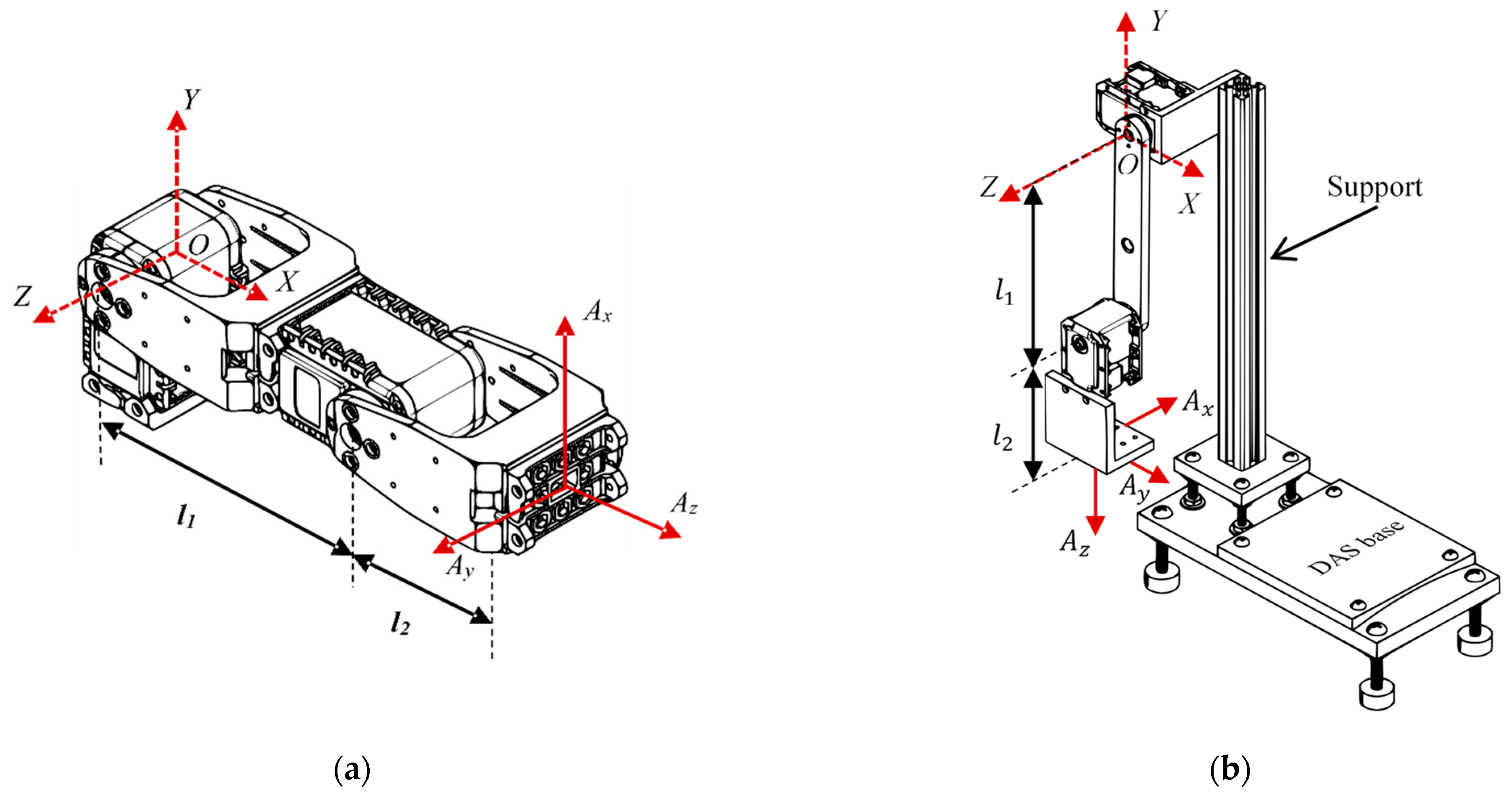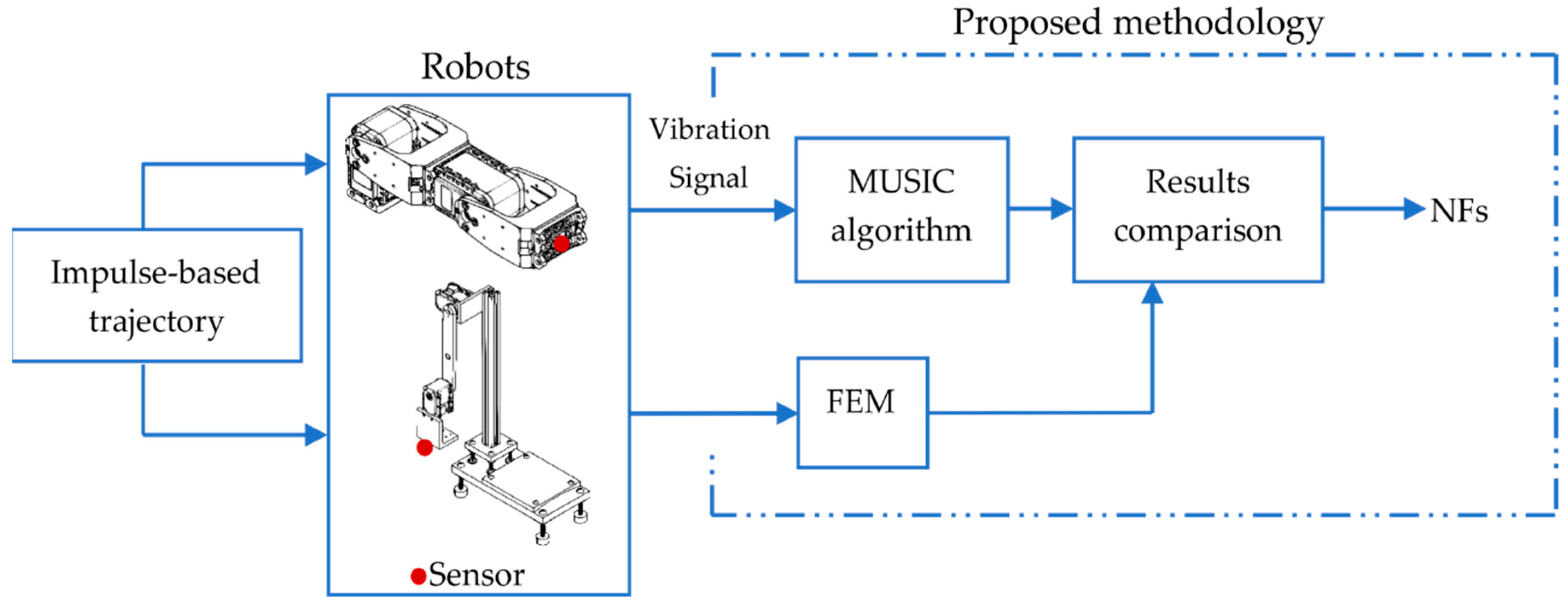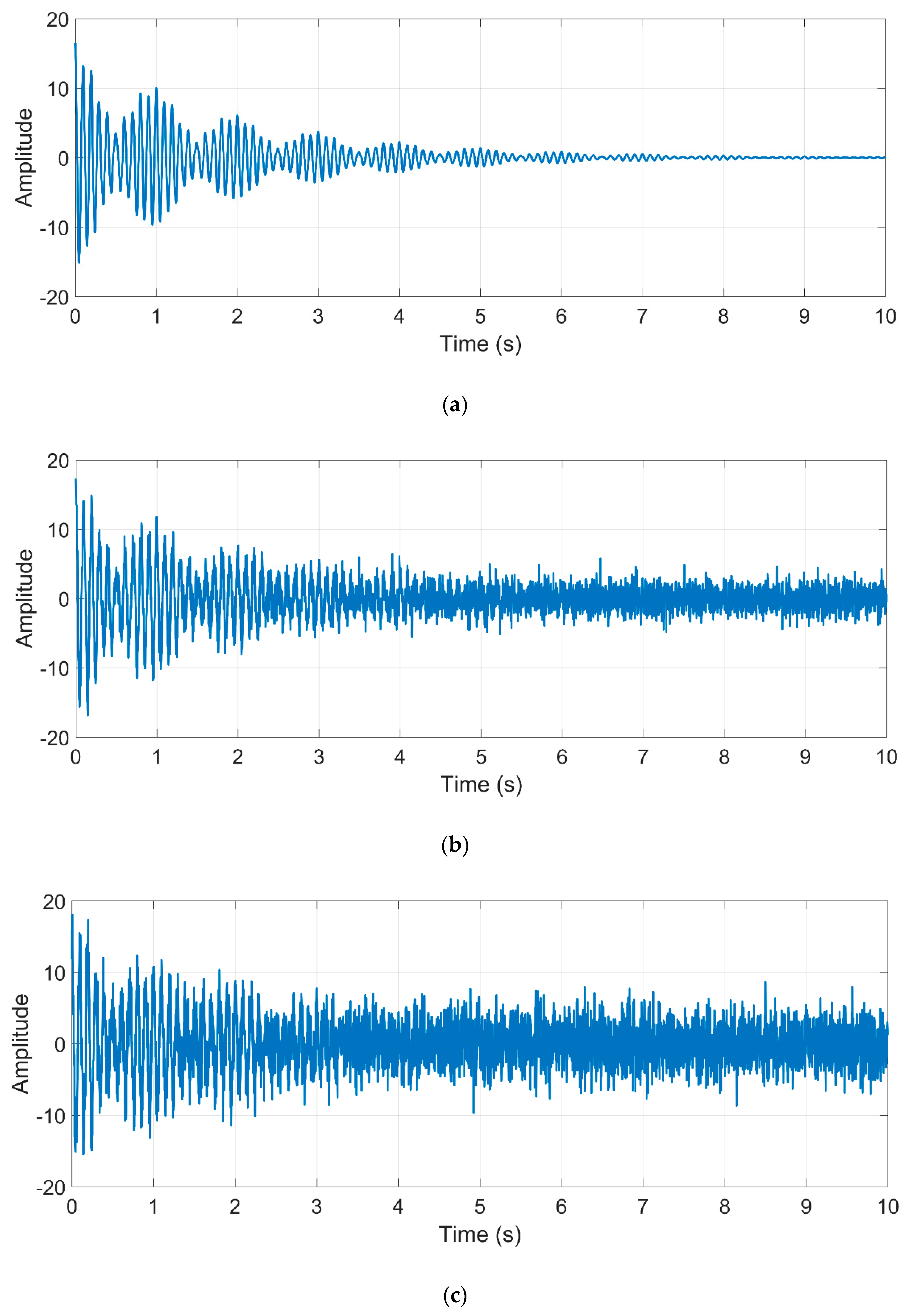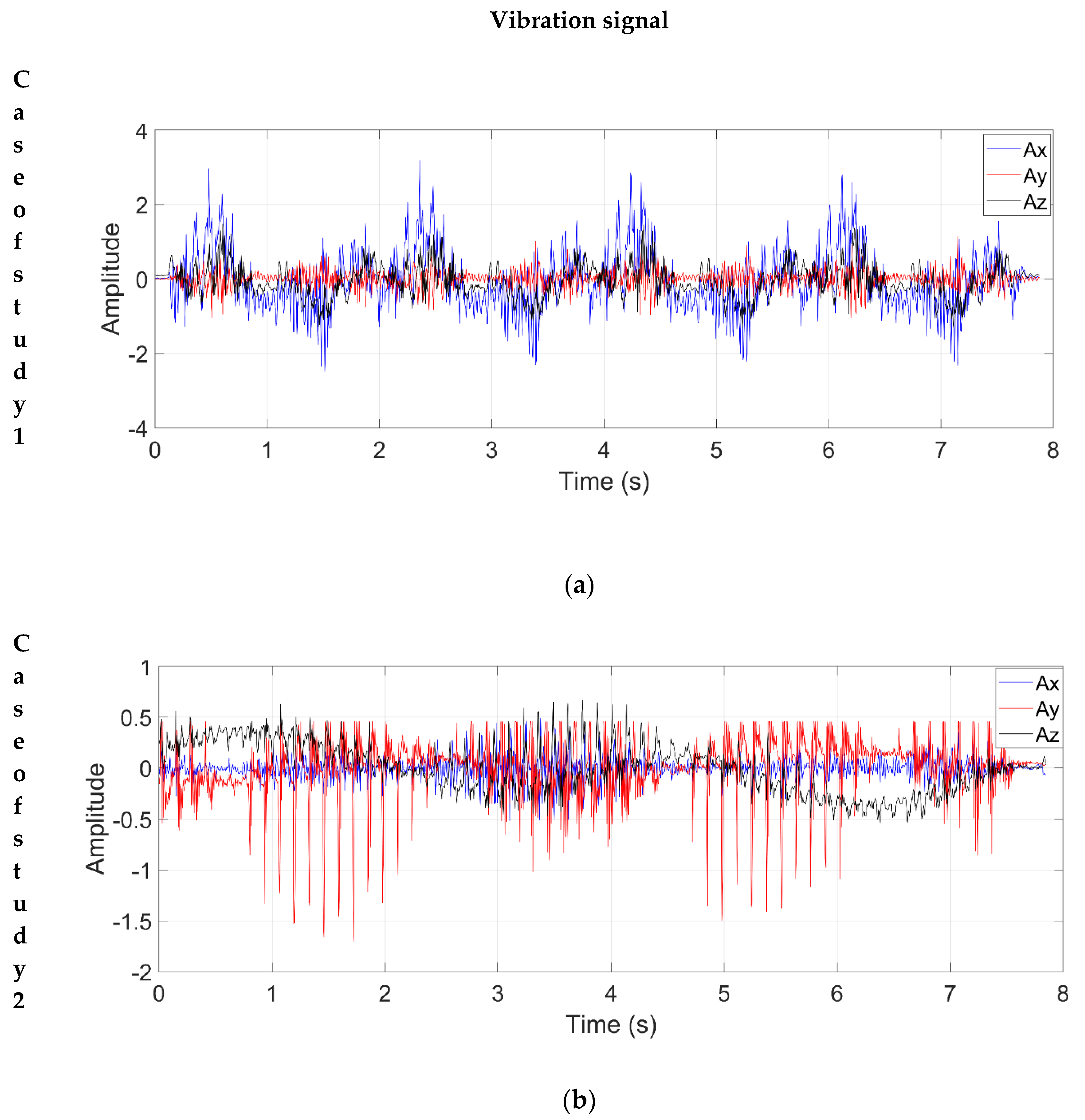Natural Frequencies Identification by FEM Applied to a 2-DOF Planar Robot and Its Validation Using MUSIC Algorithm
Abstract
:1. Introduction
2. System Description
2.1. Description of 2-DOF Planar Robot
2.2. Dynamic Model
3. Natural Frequencies Identification
3.1. Multiple Signal Classification Algorithm
3.2. MUSIC Verification Using Simulation Signals
4. Numerical and Experimental Results
4.1. Finite Element Analysis
4.2. Experimental Setup
4.3. Experimental Results
5. Results and Discussion
6. Conclusions
Author Contributions
Funding
Institutional Review Board Statement
Informed Consent Statement
Data Availability Statement
Conflicts of Interest
References
- Kalani, H.; Moghimi, S.; Akbarzadeh, A. Toward a bio-inspired rehabilitation aid: sEMG-CPG approach for online generation of jaw trajectories for a chewing robot. Biomed. Signal Process. Control 2019, 51, 285–295. [Google Scholar] [CrossRef]
- Nhon, P.N.Q.; Elamvazuthi, I.; Fayek, H.M.; Parasuraman, S.; Ahamed Khan, M.K.A. Intelligent control of rehabilitation robot: Auto tuning PIDController with interval type 2 fuzzy for DC servomotor. Procedia Comput. Sci. 2014, 42, 183–190. [Google Scholar] [CrossRef] [Green Version]
- Ohta, P.; Valle, L.; King, J.; Low, K.; Yi, J.; Atkeson, C.G.; Park, Y.-L. Design of a Lightweight Soft Robotic Arm Using Pneumatic Artificial Muscles and Inflatable Sleeves. Soft Robot. 2018, 5, 204–215. [Google Scholar] [CrossRef] [PubMed] [Green Version]
- Du, G.; Chen, M.; Liu, C.; Zhang, B.; Zhang, P. Online robot teaching with natural human-robot interaction. IEEE Trans. Ind. Electron. 2018, 65, 9571–9581. [Google Scholar] [CrossRef]
- Dupeyroux, J.; Viollet, S.; Serres, J.R. An ant-inspired celestial compass applied to autonomous outdoor robot navigation. Robot. Auton. Syst. 2019, 117, 40–56. [Google Scholar] [CrossRef]
- Hernandez-Mendez, S.; Marin-Hernandez, A.; Palacios-Hernandez, E.R.; Luna-Gallegos, K.L. A switching position/force controller for two independent finger gripper over ROS. In Proceedings of the International Conference on Electronics, Communications and Computers (CONIELECOMP), Cholula, Mexico, 22–24 February 2017; pp. 1–6. [Google Scholar] [CrossRef]
- Zhu, Y.; Jin, B.; Wu, Y.; Guo, T.; Zhao, X. Trajectory correction and locomotion analysis of a hexapod walking robot with semi-round rigid feet. Sensors 2016, 16, 1392. [Google Scholar] [CrossRef]
- Dutta, S.; Miura-Mattausch, M.; Ochi, Y.; Yorino, N.; Mattausch, H.J. Gyro-Sensor-Based Vibration Control for Dynamic Humanoid-Robot Walking on Inclined Surfaces. Sensors 2020, 20, 7139. [Google Scholar] [CrossRef]
- Tuvayanond, W.; Parnichkun, M. Position control of a pneumatic surgical robot using PSO based 2-DOF H∞ loop shaping structured controller. Mechatronics 2017, 43, 40–55. [Google Scholar] [CrossRef]
- Kim, T.-I.; Bahn, W.; Yoon, J.M.; Han, J.S.; Park, J.H.; Lee, S.S.; Lee, S.H.; Cho, D. Il Online tuning method for notch filter depth in industrial servo systems. In Proceedings of the 35th Chinese Control Conference (CCC), Chengdu, China, 27–29 July 2016; pp. 9514–9518. [Google Scholar] [CrossRef]
- Oh, T.-H.; Han, J.-S.; Kim, Y.-S.; Yang, D.-Y.; Lee, S.-H.; Cho, D.-I. “Dan” Deep RL Based Notch Filter Design Method for Complex Industrial Servo Systems. Int. J. Control. Autom. Syst. 2020, 18, 1–10. [Google Scholar] [CrossRef]
- Hoogendijk, R.; Heertjes, M.F.; Van De Molengraft, M.J.G.; Steinbuch, M. Directional notch filters for motion control of flexible structures. Mechatronics 2014, 24, 632–639. [Google Scholar] [CrossRef]
- Bottin, M.; Cocuzza, S.; Comand, N.; Doria, A. Modeling and identification of an industrial robot with a selective modal approach. Appl. Sci. 2020, 10, 4619. [Google Scholar] [CrossRef]
- Sun, J.; Zhang, W.; Dong, X. Natural Frequency Prediction Method for 6R Machining Industrial Robot. Appl. Sci. 2020, 10, 8138. [Google Scholar] [CrossRef]
- Palmieri, G.; Martarelli, M.; Palpacelli, M.C.; Carbonari, L. Configuration-dependent modal analysis of a Cartesian parallel kinematics manipulator: Numerical modeling and experimental validation. Meccanica 2014, 49, 961–972. [Google Scholar] [CrossRef]
- Siva, I.; Sangaran, D.K.; Balan, P.P.; Siddharth, P.; Sankar, I. Modal analysis on the additive manufactured robotic segments: Effect of printing densities on the vibrational properties. Mater. Today Proc. 2020. [Google Scholar] [CrossRef]
- He, D. Finite Element Analysis of Humanoid Robot Arm. In Proceedings of the 13th International Conference on Ubiquitous Robots and Ambient Intelligence (URAI), Xi’an, China, 19–22 August 2016; pp. 772–776. [Google Scholar]
- Berninger, T.F.C.; Fuderer, S.; Rixen, D.J. Modal analysis of a 7 DoF sweet pepper harvesting robot. Conf. Proc. Soc. Exp. Mech. Ser. 2020, 8, 163–170. [Google Scholar] [CrossRef]
- Tang, A.; Li, Y.; Kong, L.; Cheng, X. Vibration analysis of tendon-based parallel robot for processing. Adv. Mater. Res. 2013, 655–657, 1086–1091. [Google Scholar] [CrossRef]
- Jo, W.; Park, H.; Lee, B.; Kim, D. A study on improving sound quality of violin playing robot. In Proceedings of the 6th International Conference on Automation, Robotics and Applications (ICARA), Queenstown, New Zealand, 17–19 February 2015; pp. 185–191. [Google Scholar] [CrossRef]
- Kondo, N.; Taniwaki, S.; Tanihara, K.; Yata, K.; Monta, M.; Kurita, M.; Tsutumi, M. An End-Effector and Manipulator Control for Tomato Cluster Harvesting Robot; ASABE: St. Joseph, MI, USA, 2007. [Google Scholar]
- Min, F.; Wang, G.; Liu, N. Collision detection and identification on robot manipulators based on vibration analysis. Sensors 2019, 19, 1080. [Google Scholar] [CrossRef] [Green Version]
- Yuan, L.; Sun, S.; Pan, Z.; Ding, D.; Gienke, O.; Li, W. Mode coupling chatter suppression for robotic machining using semi-active magnetorheological elastomers absorber. Mech. Syst. Signal Process. 2019, 117, 221–237. [Google Scholar] [CrossRef]
- Dziedziech, K.; Staszewski, W.J.; Basu, B.; Uhl, T. Wavelet-based detection of abrupt changes in natural frequencies of time-variant systems. Mech. Syst. Signal Process. 2015, 64–65, 347–359. [Google Scholar] [CrossRef]
- Morinigo-Sotelo, D.; Romero-Troncoso, R.D.J.; Panagiotou, P.A.; Antonino-Daviu, J.A.; Gyftakis, K.N. Reliable Detection of Rotor Bars Breakage in Induction Motors via MUSIC and ZSC. IEEE Trans. Ind. Appl. 2018, 54, 1224–1234. [Google Scholar] [CrossRef]
- Elsayed, Y.; Vincensi, A.; Lekakou, C.; Geng, T.; Saaj, C.M.; Ranzani, T.; Cianchetti, M.; Menciassi, A. Finite Element Analysis and Design Optimization of a Pneumatically Actuating Silicone Module for Robotic Surgery Applications. Soft Robot. 2014, 1, 255–262. [Google Scholar] [CrossRef] [Green Version]
- Teshigawara, S.; Tsutsumi, T.; Shimizu, S.; Suzuki, Y.; Ming, A.; Ishikawa, M.; Shimojo, M. Highly sensitive sensor for detection of initial slip and its application in a multi-fingered robot hand. In Proceedings of the IEEE International Conference on Robotics and Automation, Shanghai, China, 9–13 May 2011; pp. 1097–1102. [Google Scholar] [CrossRef]
- Chen, S.L.; Liu, J.J.; Lai, H.C. Wavelet analysis for identification of damping ratios and natural frequencies. J. Sound Vib. 2009, 323, 130–147. [Google Scholar] [CrossRef]
- Klepka, A.; Uhl, T. Identification of modal parameters of non-stationary systems with the use of wavelet based adaptive filtering. Mech. Syst. Signal Process. 2014, 47, 21–34. [Google Scholar] [CrossRef]
- Amezquita-Sanchez, J.P.; Cabal-Yepez, E.; Romero-Troncoso, R.J.; Osornio-Rios, R.A.; Garcia-Perez, A. Determination of system frequencies in mechanical systems during shutdown transient. J. Sci. Ind. Res. 2010, 69, 415–421. [Google Scholar]
- Garcia–Perez, A.; Romero-Troncoso, R.J.; Cabal-Yepez, E.; A Osornio-Rios, R.; A Lucio-Martinez, J. Application of high-resolution spectral analysis for identifying faults in induction motors by means of sound. J. Vib. Control. 2012, 18, 1585–1594. [Google Scholar] [CrossRef]
- Zamudio-Ramirez, I.; Ramirez-Nunez, J.A.; Antonino-Daviu, J.; Osornio-Rios, R.A.; Quijano-Lopez, A.; Razik, H.; De Jesus Romero-Troncoso, R. Automatic Diagnosis of Electromechanical Faults in Induction Motors Based on the Transient Analysis of the Stray Flux via MUSIC Methods. IEEE Trans. Ind. Appl. 2020, 56, 3604–3613. [Google Scholar] [CrossRef]
- Amezquita-Sanchez, J.P.; Garcia-Perez, A.; Romero-Troncoso, R.J.; Osornio-Rios, R.A.; Herrera-Ruiz, G. High-resolution spectral-analysis for identifying the natural modes of a truss-type structure by means of vibrations. J. Vib. Control 2013, 19, 2347–2356. [Google Scholar] [CrossRef]
- Perez-Ramirez, C.A.; Machorro-Lopez, J.M.; Valtierra-Rodriguez, M.; Amezquita-Sanchez, J.P.; Garcia-Perez, A.; Camarena-Martinez, D.; Romero-Troncoso, R.D.J. Location of multiple damage types in a truss-type structure using multiple signal classification method and vibration signals. Mathematics 2020, 8, 932. [Google Scholar] [CrossRef]
- Gkoktsi, K.; Giaralis, A. A compressive MUSIC spectral approach for identification of closely-spaced structural natural frequencies and post-earthquake damage detection. Probabilistic Eng. Mech. 2020, 60. [Google Scholar] [CrossRef]
- Zhang, Z.; Zhong, Y.; Xiang, J. TAM and MUSIC Approach for Impact-Source Localization under Deformation Conditions. Sensors 2020, 20, 3151. [Google Scholar] [CrossRef]
- Heckbert, P. Fourier Transforms and the Fast Fourier Transform (FFT) Algorithm. Notes Comput. Graph. 1995, 3, 15–463. [Google Scholar]
- Nikkhah, A.; Yousefi-Koma, A.; Mirjalili, R.; Farimani, H.M. Design and Implementation of Small-sized 3D Printed Surena-Mini Humanoid Platform. In Proceedings of the 5th RSI International Conference on Robotics and Mechatronics (ICRoM), Tehran, Iran, 25–27 October 2017; pp. 132–137. [Google Scholar] [CrossRef]
- Kelly, R.; Davila, V.S.; Perez, J.A.L. Control of Robot Manipulators in Joint Space; Springer: London, UK, 2006. [Google Scholar]
- Schmidt, R.O. Multiple emitter location and signal parameter estimation. Adapt. Antennas Wirel. Commun. 2009, 776, 190–194. [Google Scholar] [CrossRef] [Green Version]
- Bienvenu, G.; Kopp, L. Optimality of High Resolution Array Processing Using the Eigensystem Approach. IEEE Trans. Acoust. 1983, 31, 1235–1248. [Google Scholar] [CrossRef]
- Kia, S.H.; Henao, H.; Capolino, G.A. A high-resolution frequency estimation method for three-phase induction machine fault detection. IEEE Trans. Ind. Electron. 2007, 54, 2305–2314. [Google Scholar] [CrossRef]
- Tamura, H.; Ohgami, N.; Yajima, I.; Iida, M.; Ohgami, K.; Fujii, N.; Itabe, H.; Kusudo, T.; Yamashita, H.; Kato, M. Chronic exposure to low frequency noise at moderate levels causes impaired balance in mice. PLoS ONE 2012, 7, e39807. [Google Scholar] [CrossRef]
- Granados-Lieberman, D.; Romero-Troncoso, R.J.; Cabal-Yepez, E.; Osornio-Rios, R.A.; Franco-Gasca, L.A. A real-time smart sensor for high-resolution frequency estimation in power systems. Sensors 2009, 9, 7412–7429. [Google Scholar] [CrossRef] [Green Version]
- Bao, C.; Hao, H.; Li, Z.X.; Zhu, X. Time-varying system identification using a newly improved HHT algorithm. Comput. Struct. 2009, 87, 1611–1623. [Google Scholar] [CrossRef]
- Chen, G.; Wang, Z. A signal decomposition theorem with Hilbert transform and its application to narrowband time series with closely spaced frequency components. Mech. Syst. Signal Process. 2012, 28, 258–279. [Google Scholar] [CrossRef]
- Romero-Troncoso, R.D.J. Multirate Signal Processing to Improve FFT-Based Analysis for Detecting Faults in Induction Motors. IEEE Trans. Ind. Inform. 2017, 13, 1291–1300. [Google Scholar] [CrossRef]
- Press, W.H.; Teukolsky, S.A.; Vettering, W.T.; Flannery, B.P. Numerical Recipes—The Art of Scientific Computing, 3rd ed.; Cambridge University Press: Cambridge, UK, 2007. [Google Scholar] [CrossRef]
- Li, T.; Tang, Y. Frequency estimation based on modulation FFT and MUSIC algorithm. In Proceedings of the 1st International Conference on Pervasive Computing, Signal Processing and Applications, Harbin, China, 17–19 September 2010; Volume 525, pp. 525–528. [Google Scholar] [CrossRef]










| Case of Study 1 | Case of Study 2 | |
|---|---|---|
| Actuators | Dynamixel AX-12 | Dynamixel MX-28 |
| Material link | Polymeric | Aluminum 6061 |
| Total weight | 0.16 kg | 0.7475 kg |
| 0.093 m | 0.14 m | |
| 0.081 m | 0.081 m | |
| 0.0219 kg | 0.0566 kg | |
| 0.0219 kg | 0.0712 kg | |
| m2 | m2 | |
| m2 | m2 |
| Dynamixel AX-12 | Dynamixel MX-28 | |
|---|---|---|
| Weight | 0.0546 kg | 0.072 kg |
| Dimensions | 0.032 m 0.05 m 0.04 m | 0.0356 m 0.0506 m 0.0355 m |
| Max. torque | 1.52 Nm | 2.5 Nm |
| Mode | Theoretical Frequency (Hz) | FFT Method (Error %) | MUSIC Method (Error %) | ||||
|---|---|---|---|---|---|---|---|
| WN | MLN | HLN | WN | MLN | HLN | ||
| 1 | 10 | 10.3 (3) | 10.5 (5.5) | 10.5 (5.5) | 10 (0.0) | 10.01 (0.1) | 10.01 (0.1) |
| 2 | 11 | NI | NI | NI | 11 (0.0) | 10.98 (0.18) | 10.98 (0.18) |
| 3 | 15 | 16 (6.6) | 15.8 (5.3) | NI | 15 (0.0) | 15.01 (0.06) | 15.25 (1.66) |
| 4 | 30 | 31 (3.3) | NI | NI | 30 (0.0) | 30.27 (0.9) | 32.34 (1.06) |
| Natural Frequencies (Hz) | ||
|---|---|---|
| Mode | Case of Study 1 | Case of Study 2 |
| 1 | 19.765 | 35.987 |
| 2 | 42.622 | 38.866 |
| 3 | 63.427 | 63.736 |
| 4 | 86.386 | 77.029 |
| 5 | 100.580 | 79.952 |
| Natural Frequencies (Hz) | ||||
|---|---|---|---|---|
| Mode | Case of Study 1 | Case of Study 2 | ||
| MUSIC | FFT | MUSIC | FFT | |
| 1 | 19.53 | 20 | 34.79 | 40.5 |
| 2 | 38.94 | 34 | 38.33 | 40.5 |
| 3 | 63.35 | 63.5 | 62.99 | 61.5 |
| 4 | 86.3 | 85.5 | 77.03 | 81.5 |
| 5 | 101.3 | 103 | 80.93 | 81.5 |
| Natural Frequencies (Hz) | ||||||
|---|---|---|---|---|---|---|
| Case of Study 1 | Case of Study 2 | |||||
| Modes | FEM | FFT | MUSIC | FEM | FFT | MUSIC |
| 1 | 19.765 | 20 | 19.53 | 35.987 | 40.5 | 34.79 |
| 2 | 42.622 | 34 | 38.94 | 38.866 | 40.5 | 38.33 |
| 3 | 63.427 | 63.5 | 63.35 | 63.736 | 61.5 | 62.99 |
| 4 | 86.386 | 85.5 | 86.3 | 77.029 | 81.5 | 77.03 |
| 5 | 100.580 | 103 | 101.3 | 79.952 | 81.5 | 80.93 |
Publisher’s Note: MDPI stays neutral with regard to jurisdictional claims in published maps and institutional affiliations. |
© 2021 by the authors. Licensee MDPI, Basel, Switzerland. This article is an open access article distributed under the terms and conditions of the Creative Commons Attribution (CC BY) license (http://creativecommons.org/licenses/by/4.0/).
Share and Cite
Martínez-Cruz, S.; Amézquita-Sánchez, J.P.; Pérez-Soto, G.I.; Rivera-Guillén, J.R.; Morales-Hernández, L.A.; Camarillo-Gómez, K.A. Natural Frequencies Identification by FEM Applied to a 2-DOF Planar Robot and Its Validation Using MUSIC Algorithm. Sensors 2021, 21, 1209. https://doi.org/10.3390/s21041209
Martínez-Cruz S, Amézquita-Sánchez JP, Pérez-Soto GI, Rivera-Guillén JR, Morales-Hernández LA, Camarillo-Gómez KA. Natural Frequencies Identification by FEM Applied to a 2-DOF Planar Robot and Its Validation Using MUSIC Algorithm. Sensors. 2021; 21(4):1209. https://doi.org/10.3390/s21041209
Chicago/Turabian StyleMartínez-Cruz, Salvador, Juan P. Amézquita-Sánchez, Gerardo I. Pérez-Soto, Jesús R. Rivera-Guillén, Luis A. Morales-Hernández, and Karla A. Camarillo-Gómez. 2021. "Natural Frequencies Identification by FEM Applied to a 2-DOF Planar Robot and Its Validation Using MUSIC Algorithm" Sensors 21, no. 4: 1209. https://doi.org/10.3390/s21041209
APA StyleMartínez-Cruz, S., Amézquita-Sánchez, J. P., Pérez-Soto, G. I., Rivera-Guillén, J. R., Morales-Hernández, L. A., & Camarillo-Gómez, K. A. (2021). Natural Frequencies Identification by FEM Applied to a 2-DOF Planar Robot and Its Validation Using MUSIC Algorithm. Sensors, 21(4), 1209. https://doi.org/10.3390/s21041209











